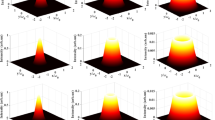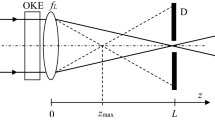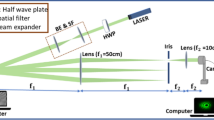Abstract
This paper considers the calculation of the nonlinear losses induced in a circular aperture enlighten by a focused Gaussian beam (GB) subject to optical Kerr effect. Such a problem known since a long time typically requires the numerical calculation of a diffraction integral which becomes rapidly cumbersome in the case of repetitive applications. Alternatively, we propose a new simple modelling completely analytical. This method called as Non Gaussian Gaussian Beam modelling is based on the beam propagation factor \(M^{2} > 1\) of the GB traversing the Kerr aberration. The \(M^{2}\) is found to depend only on the nonlinear Kerr phase shift and independent of the wavelength and the width of the GB incident on the Kerr medium. This simple modelling has been applied to three applications: Kerr Lens Mode locking (KLM) mechanism, optical limitation, and Z-scan technique for a large nonlinearity.

















Similar content being viewed by others
References
Sheik-Bahee M, Said AA, Wei TH, Hagan DJ, Van Stryland EW (1990) Sensitive measurement of optical nonlinearities using a single beam. IEEE J. Quantum Electron. 26:760–769.
D. Spence, P. Kean, W. Sibbett, 60-fsec pulse generation from a self-mode locked Ti:sapphire laser. Opt. Lett. 16, 42–44 (1991)
Yefet S, Pe’er A (2013) A review of cavity design for Kerr Lens mode-locked solid-state lasers. Appl. Sci. 3: 694–724.
Hasnaoui A, Fromager M, Ait-Ameur K (2019) About the validity of the parabolic approximation in Kerr lensing effect. Optik. 193 162986.
M. Soileau, W. Williams, E. Van Stryland, Optical power limiter with picosecond response time. IEEE J. Quantum Electron. 19, 731–735 (1983)
J. Hermann, Beam propagation and optical power limiting with nonlinear media. J. Opt. Soc. Am. B 1, 729–736 (1984)
J. Hermann, Simple model for a passive optical power limiter. Opt. Acta 32, 541–547 (1985)
J. Hermann, External self-focusing, self-bending and optical limiting with thin non-linear media. Opt. Quantum Electron. 19, 169–178 (1987)
M. Sheik-Bahae, A. Said, D. Hagan, M. Soileau, E. Van Stryland, Simple analysis and geometric optimization of a passive optical limiter based on internal self-action. Proc. SPIE 1105, 146–153 (1989)
J. Hermann, Self-focusing effects and applications using thin nonlinear media. Int. J. Nonlinear Phys. 1, 541–561 (1992)
L. Tutt, T. Boggess, A review of optical limiting mechanisms and devices using organic, fullerenes, semiconductors and other materials. Prog. Quantum Electron. 17, 299–338 (1993)
F. Hernandez, S. Yang, V. Dubikovskiy, W. Shensky, E. Van Stryland, D. Hagan, Dual focal plane visible optical limiter. J. Nonlinear Opt. Phys. Mat. 9, 423–440 (2000)
M. Soileau, W. Williams, E. Van Stryland,” Optical power limiter with picosecond response time “, IEEE J. Quantum Electron. 19 (1983) 731–735.
A.E. Siegman, “Defining and measuring laser beam quality”, Solid State Lasers, NATO ASI Series book series, Springer, Boston, vol. 137 (1993) 13-28
H. Sun, Thin lens equation of a real laser beam with weak lens aperture truncation. Opt. Eng. 37, 2906–2913 (1998)
H. Kogelnik, Imaging of optical modes-resonators with internal lenses. Bell Syst. Tech. J. 44, 455–494 (1965)
L. Deng, K. He, T. Zhou, C. Li, Formation and evolution of far-field diffraction patterns of divergent and convergent Gaussian beams passing through self-focusing and self-defocusing media. J. Opt. A 7, 409–415 (2005)
B. Mercier, J.P. Rousseau, A. Jullien, L. Antonucci, « Nonlinear beam shaper for femtosecond laser pulses, from Gaussian to flat-top profile. Opt. Commun. 283, 2900–2907 (2010)
V. Magni, G. Cerullo, S. De. Silvestri, Closed form Gaussian beam analysis of resonators containing a Kerr medium for femtosecond lasers. Opt. Commun. 101, 365–370 (1993)
J. Xia, M.H. Lee, Analysis of cavities for self-starting Kerr-lens mode-locked lasers. Appl. Opt. 41, 453–458 (2002)
Z. Li, J. Peng, J. Yao, M. Huan, Q. Cao, The characteristics of Kerr lens mode-locked Nd:YVO4 laser with a symmetrical z-shaped cavity. J. Mod. Opt. 64, 1302–1306 (2017)
M.Z. Alam, S.A. Schulz, J. Upham, I. De. Leon, R.W. Boyd, Large optical nonlinearity of nanoantennas coupled to an epsilon-near-zero material. Nat. Photonics 12, 79–83 (2018)
P. Guo, R.D. Schaller, L.E. Ocola, B.T. Diroll, J.B. Ketterson, R. Chang, Large optical nonlinearity of ITO nanorods for sub-picosecond all-optical modulation of the full-visible spectrum. Nat. Commun. (2016). https://doi.org/10.1038/ncomms12892
S.Q. Chen, Z.B. Liu, W.P. Zang, J.G. Tian, W.Y. Zhou, F. Song, C.P. Zhang, “Study on Z-scan characteristics for a large nonlinear phase shift”, J.O.S.A. B 22, 1911–1916 (2005).
A.B. Ortega, M.L. Arroyo Carrasco, M.M. Mendez Otero, E. Reynoso Lara, E.V. Garcia Ramirez, M.D. Iturbe Castillo, “Analytical expressions for Z-scan with arbitrary phase change in thin nonlocal nonlinear media”, Opt. Express 22, 27932–27941 (2014).
L. Palfalvi, B.C. Toth, G. Almasi, J.A. Fülöp, J. Hebling, A general Z-scan theory. Appl. Phys. B 97, 679–685 (2009)
L. Sarkhosh, N. Mansour, Analysis of Z-scan measurement for large thermal nonlinear refraction in gold nanoparticle colloid. J. Nonlinear Opt. Phys. Mat. 24, 1550014 (2015)
C. Jacinto, D.N. Messias, A.A. Andrade, S.M. Lima, M.L. Baesso, T. Catunda, Thermal lens and Z-scan measurements: thermal and optical properties of laser glasses-a review. J. Non-Crystalline Solids 352, 3582–3597 (2006)
K. Tanaka, N. Sage, H. Mizokami, Field spread of a diffracted Gaussian beam through a circular aperture. Appl. Opt. 24, 1102–1105 (1985)
T. Godin, A. Forbes, D. Naidoo, M. Fromager, E. Cagniot, K. Aït-Ameur, Transverse correlation vanishing due to phase aberration. Opt. Commun. 284, 4601–4606 (2011)
K. Aït-Ameur, « Amplitude and phase clipping: Strehl ratio versus divergence”. Opt. Commun. 285, 699–705 (2012)
I.S. Gradshteyn, I.M. Ryzhik, “Table of Integrals, Series and Products” 7th Edn (2007) New York:Elsevier, p. 108.
Funding
This research did not receive any specific grant from funding agencies in the public, commercial, or not-for-profit sectors.
Author information
Authors and Affiliations
Corresponding author
Additional information
Publisher's Note
Springer Nature remains neutral with regard to jurisdictional claims in published maps and institutional affiliations.
Appendices
Appendix 1
The direct calculation of \(T_{D}\) the aperture transmission is based on the knowledge of \(I_{d} (r,z) = \left| {E_{d} (r,z)} \right|^{2}\) the diffracted intensity distribution of the intensity beam of electrical field distribution \(E_{{{\text{in}}}} (\rho )\) and having traversed the Kerr medium of transmittance (field ratio) \(\exp [ - i\Delta \varphi (\rho )]\) followed by the thin focusing lens of transmittance \(\exp [ik\rho ^{2} /(2f_{L} )]\); where r (\(\rho\)) is the radial coordinate in plane z (lens plane).
The collimated incident beam is assumed to be Gaussian and characterised by the electrical field given by:
where W = 1 mm is the Gaussian beam width and P the beam power.
The diffracted field distribution \(E_{d} (r,L)\) in the aperture plane is obtained using the Fresnel–Kirchhoff integral:
Depending on the beam power, i.e. the on-axis nonlinear phase shift, the diffracted intensity distribution in the aperture plane is in general no longer Gaussian in shape, and has to be characterised by a beam width based on the second-order intensity moment noted \(W_{D} (L)\), and defined as follows:
Appendix 2
The aim of this appendix is to demonstrate that considering two laser beams having an intensity profile \(I_{1} (\rho )\) and \(I_{2} (\rho )\) characterised by the same width based on the second-order intensity moment, their transmissions through a given diaphragm can be very different. For that, we will consider the particular case where the two beams are \(LG_{{00}}\) (Gaussian) and \(LG_{{01}}\) (doughnut) beams having intensity profile given by:
The Gaussian (doughnut) beam has a width \(W_{1}\) (\(W_{2}\)). As pointed out above, we will assume the same width for the two beams, and consequently we have the following relationship:
By definition, the transmission (ratio of powers) through a circular aperture of radius \(R_{D}\) of a laser beam having an intensity profile \(I(\rho )\) is given by:
The integral in Eq. (37) for the \(LG_{{01}}\) beam involves the product of a Gaussian function and a polynomial. Its calculation can be found using a table of integrals [32] which provides the following result:
If we set \(Y = R_{D} /W_{2}\), then we obtain the transmission \(T_{1}\) (\(T_{2}\)) for the Gaussian (doughnut) beam:
Figure
18 shows the variations of \(T_{1}\) and \(T_{2}\) versus Y, and it is seen that, except for Y close to 0.6, \(T_{1} \ne T_{2}\) although the two beams have the same width based on the second-order intensity moment.
Rights and permissions
About this article
Cite this article
Hasnaoui, A., Ait-Ameur, K. Simple modelling of nonlinear losses induced by Kerr lensing effect. Appl. Phys. B 127, 100 (2021). https://doi.org/10.1007/s00340-021-07646-1
Received:
Accepted:
Published:
DOI: https://doi.org/10.1007/s00340-021-07646-1





